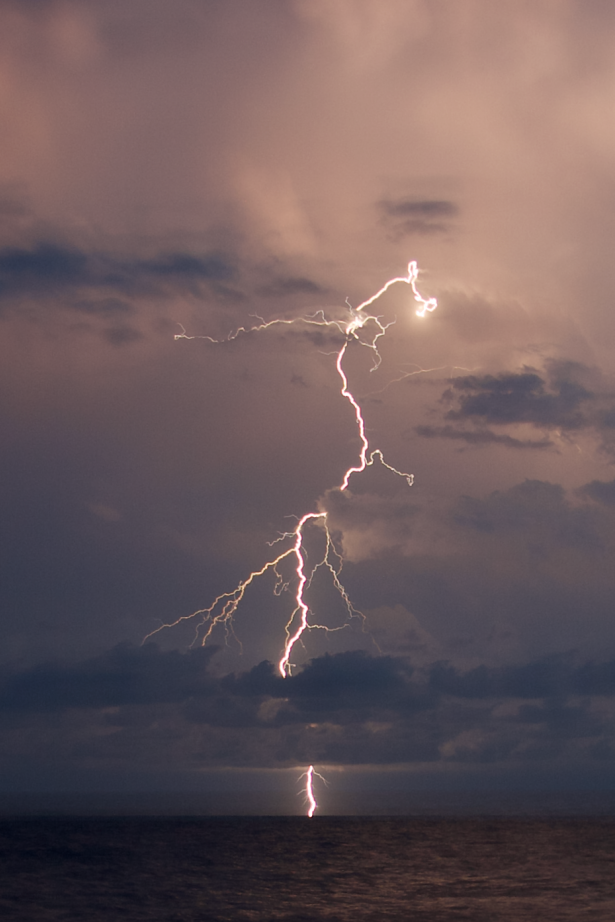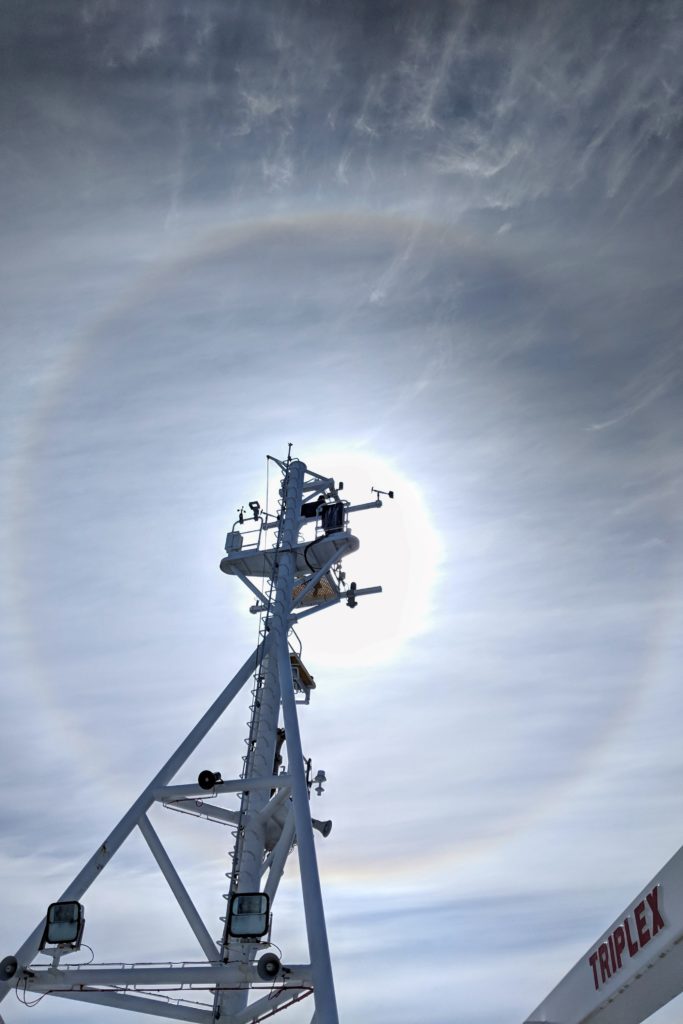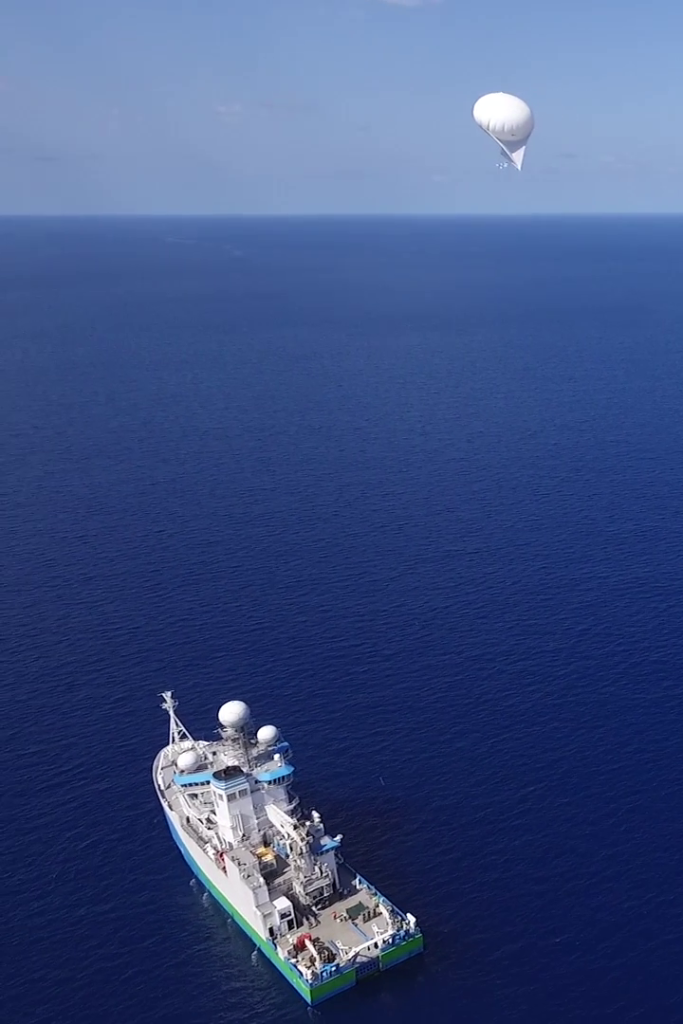Research vessel (RV) Investigator is an inimitable science ship. It bristles with sensors and instruments for studying the stormy skies above our oceans. Included in its atmospheric arsenal is one very unique piece of equipment located in the iconic ‘soccer ball’ atop the ship. Spinning within is an advanced weather radar. This collects weather data within a 150 kilometre (km) radius from the ship and 20 km up into the atmosphere.
The weather radar reveals the location, size and shape of clouds and storms. It also lets scientists see if a cloud is made from water, snow or ice. Although sometimes on board, we look even higher than the clouds!
The ship also has dedicated systems to measure aerosols and gases in the atmosphere, everywhere it goes. Across the globe, an extensive network of specialised monitoring stations delivers similar data to the Global Atmospheric Watch (GAW) program of the World Meteorological Organisation (WMO). This program watches the world’s atmosphere, its composition and, importantly, how it is changing.
This includes our Kennaook/Cape Grim Baseline Air Pollution Station on Tasmania’s west coast. This is one of three premier stations in the GAW network.
Before RV Investigator sailed onto the scene, all GAW stations around the world were land based. That all changed in 2018. With its unique atmospheric capabilities and the technical expertise of its staff, RV Investigator was recognised as the world’s first mobile GAW station.
With the ship’s versatile capabilities, scientists have been studying up a storm to help us better understand and predict weather in our region.

Storm chasing in northern waters
At the end of 2019, a collaborative research team set sail for Australia’s far northern waters to gather data to help improve weather and climate models. This RV Investigator voyage was part of an international effort to study an important region known as the ‘Maritime Continent’. This region comprises the northern part of Australia as well as the islands and seas of Indonesia, Malaysia, New Guinea, and surrounds.
The storm chasing scientists wanted to get up close and study how storms form, and the mixing of heat in the atmosphere and ocean.
Led by the Bureau of Meteorology and CSIRO, scientists collected unprecedented oceanic and atmospheric observations on this voyage. The data collected helps improve weather modelling and forecasts. Importantly, the research has helped improve our ability to detect tropical storm formation hundreds of kilometres offshore.
From north to south, scientists travel far and wide to study the atmosphere with RV Investigator.

Studying clouds above Southern Ocean skies
During a 2018 voyage to Antarctica, we led a multidisciplinary research team to study of the deep ocean and atmosphere of the Southern Ocean. The Southern Ocean plays a critical role in the Earth’s climate system. The region takes up more of the extra heat and carbon dioxide added by human activities than any other area of ocean.
The atmosphere in this region is well known to be some of cleanest air in the world. This is a key reason why the GAW station was setup at Kennaook/Cape Grim. Scientists on the 2018 voyage found that the further south they travelled from Australia, the less aerosol particles were in the air. Most of these aerosols came from ocean microorganisms including phytoplankton. Aerosols, which are particles suspended in the air, are important as they form the seed from which clouds can grow. You might say aerosols are the calm before the storm.
The type of aerosol particle is also important. It impacts the properties of the clouds. Above the Southern Ocean, there are almost no aerosol particles which can turn cloud droplets into ice crystals. This means that most of clouds in the region are still liquid, even at temperatures well below zero. We all know that clouds are great for reflecting sunlight. Less clouds, and clouds with fewer droplets, means less sunlight is reflected. As a result, more of the sun’s heat reaches the Earth's surface.
However, scientists predict that the number of aerosols above the Southern Ocean may increase with global warming. This is due to the associated increase in biological activity that warming will likely bring. This could result in Southern Ocean clouds reflecting more light, offsetting some of the warming expected from diminishing sea ice in a future climate.
Oh, and during the voyage, scientists also found the cleanest air on Earth! #HumbleBrag

Investigating if coral makes it rain
Following the aerosol trail, scientists from the Queensland University of Technology have used RV Investigator to study one of the biggest ecosystems in Australia, the Great Barrier Reef. Their aim was to determine if marine aerosol production along the Queensland coast came from corals.
In short, they were asking can corals create rain? This voyage was the first modelling study to quantify this relationship and led to a very important finding.
Corals, or more specifically the algae in them, produce a small but climatically important molecule called dimethyl sulphide (DMS). Corals produce DMS all the time. More so when they are stressed, such as when the water around them gets warmer. As DMS molecules rise from the sea into the atmosphere, they attract water. Under the right conditions, this can eventually form clouds and rain.
This research was first time an attempt was made to demonstrate that an ecological system – the Great Barrier Reef – can have significant influence on the climate and rainfall over a large part of Australia. Importantly, the research also helps tell us if there’ll be any impact on climate if we lose our coral reefs.
And their research led to a surprising and important finding. The scientists found that corals, and the DMS they release, effectively play no significant role in regulating climate or weather. There's no storm in this coral teacup. This is an important result as it’s in contrast with previous observational literature on the subject. Importantly, this finding emphasises why we collect data and how science works. You don’t always get the answer you were expecting!
Researching up a storm
Wherever it goes, from the tropics to the ice edge, RV Investigator is keeping an eye to the sky, collecting data to help us improve understanding, climate models and weather predictions for Australia.
